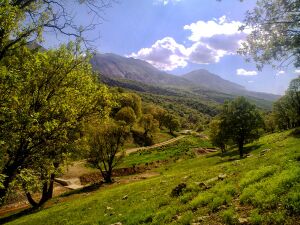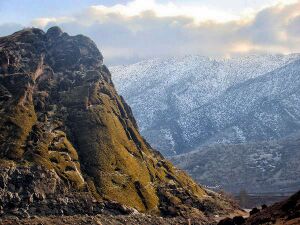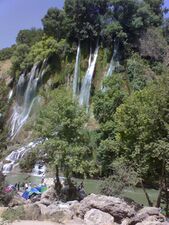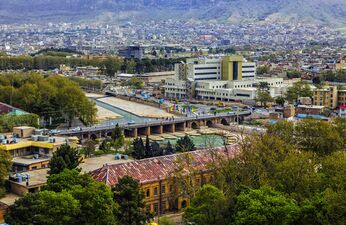Place:Khorramabad
Khorramabad Persian: خرمآباد | |
|---|---|
City | |
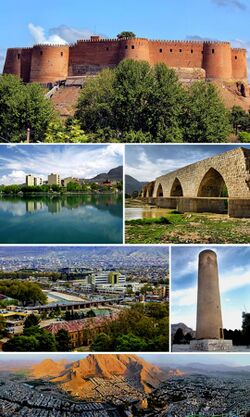 Montage of Khorramabad, Clockwise:Falak-ol-Aflak Castle, Keeyow lake, Shapuri bridge, View of the Khorramabad city, Brick Minaret, Panorama of Khorramabad | |
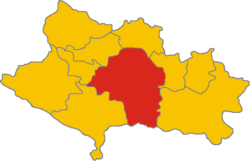 The territory of the Khorramabad inside the province of Lorestan | |
| Coordinates: [ ⚑ ] : 33°29′15″N 48°21′22″E / 33.4875°N 48.35611°E[1] | |
| Country | Iran |
| Province | Lorestan |
| County | Khorramabad |
| District | Central |
| Government | |
| • Mayor | Daryoush Barani Beiranvand [2] |
| Elevation | 1,147 m (3,763 ft) |
| Population (2016)[3] | |
| • Total | 373,416 |
| Time zone | UTC+3:30 (IRST) |
| Climate | Csa |
| Website | www.Khorramabad.ir |
Khorramabad (Persian: خرمآباد, romanized: Xorramâbâd [xoræmɒːˈbɒːd] (![]() listen)), alternatively romanized as Khorramābād, Khoramabad, Khurramabad, Khorram Abad, Xurremabad, Xorramâbâd or Khur Ramābād,[4] is a city in the Central District of Khorramabad County, Lorestan province, Iran, serving as capital of the province, the county, and the district.[5]
listen)), alternatively romanized as Khorramābād, Khoramabad, Khurramabad, Khorram Abad, Xurremabad, Xorramâbâd or Khur Ramābād,[4] is a city in the Central District of Khorramabad County, Lorestan province, Iran, serving as capital of the province, the county, and the district.[5]
At the 2006 National Census, its population was 328,544 in 75,945 households.[6] The following census in 2011 counted 348,216 people in 94,747 households.[7] The latest census in 2016 showed a population of 373,416 people in 109,231 households.[3]
Khorramabad is in the Zagros Mountains. Khorramabad Airport is 3 km south of the city proper.[8]
Although not a major tourist destination, it is quite scenic and possesses several attractions, such as five Paleolithic cave-dwelling sites.[9]
Demographics
The city population is predominantly Lur and the largest Luri-speaking city in the country.[10][11] The linguistic composition of the city:[12]
History
Hazaraspids
The founder of the Hazaraspid dynasty was Abu Tahir ibn Muhammad, a descendant of the Shabankara chieftain Fadluya. Fadluya was initially a commander of the Salghurids of Fars and was appointed governor of Kuhgiluya,[13] but eventually gained independence in Luristan and extended his realm as far as Isfahan.
Safavid dynasty
During the reign of the Safavid dynasty, Khorramabad was the administrative center of Luristan Province. In the wake of the demise of the Safavids, after the signing of the Treaty of Constantinople (1724) with Imperial Russia, the Ottomans conquered Khorramabad on the 6th of September 1725.[14]
Monuments
Brick minaret
Brick Minaret is a cylindrical brick tower from Seljuq and Buyid dynasties located inside the ancient city of Shapur khast, south of Khorramabad.
This Iranian minaret is a combination of the Indian Stupa, commemorative columns, and the central Asia tradition of tower building for defensive and communication purposes.[15]
Sahpuri Bridge
Colleges and universities
- Islamic Azad University of Khorram Abad
- Lorestan University[16]
- Lorestan University of Medical Sciences[17]
- Madanni Technical College[18]
Sister cities and twin towns
| Country | City | State / Province / Region / Governorate | Date | ||||
|---|---|---|---|---|---|---|---|
| Turkey | Afyonkarahisar | Afyonkarahisar Province | 2015[19] | ||||
| Japan | Yamagata | Yamagata Prefecture | October 2013[20] | December 2020[21] | |||
Photo gallery
Climate
Khorramabad has mild and semi-humid Mediterranean climate with high amount of rainfall during spring and winter. It is the sixth cities in Iran having high level of annual rainfall. Khorramabad has what is classed under the Köppen climate classification as a Hot-summer Mediterranean climate (Csa) climate. Its elevation is 1147.8 above sea level. Average annual precipitation is 511.06 and its average annual temperature is 17.21 Celsius.
Script error: No such module "weather box".
See also
- List of World Heritage Sites in Iran
- Khaydalu
References
- ↑ OpenStreetMap contributors (25 August 2023). "Khorramabad, Khorramabad County" (Map). OpenStreetMap. Retrieved 25 August 2023.
- ↑ https://www.irna.ir/news/85192859
- ↑ 3.0 3.1 "Census of the Islamic Republic of Iran, 1395 (2016)" (in fa) (Excel). The Statistical Center of Iran. p. 15. https://www.amar.org.ir/Portals/0/census/1395/results/abadi/CN95_HouseholdPopulationVillage_15.xlsx.
- ↑ Khorramabad can be found at GEOnet Names Server, at this link, by opening the Advanced Search box, entering "-3071194" in the "Unique Feature Id" form, and clicking on "Search Database".
- ↑ "Approval of the organization and chain of citizenship of the elements and units of the country divisions of Lorestan province, centered in the city of Khorramabad" (in fa). Ministry of Interior, Political and Defense Commission of the Government Board. 21 June 1369. https://lamtakam.com/law/council_of_ministers/113030.
- ↑ "Census of the Islamic Republic of Iran, 1385 (2006)" (in fa) (Excel). The Statistical Center of Iran. p. 15. http://www.amar.org.ir/DesktopModules/FTPManager/upload/upload2360/newjkh/newjkh/15.xls.
- ↑ "Census of the Islamic Republic of Iran, 1390 (2011)" (in fa) (Excel). The Statistical Center of Iran. p. 15. https://irandataportal.syr.edu/wp-content/uploads/Lorestan.xls.
- ↑ "Lorestan Province" (in fa). Lorestan council of dispute resolution. https://shoralr.eadl.ir/%D9%85%D8%B9%D8%B1%D9%81%D9%8A-%D8%A7%D8%B3%D8%AA%D8%A7%D9%86.[yes|permanent dead link|dead link}}]
- ↑ Baumler, Mark F. and Speth, John D. (1993) "A Middle Paleolithic Assemblage from Kunji Cave, Iran" pp. 1–74 In Olszewski, Deborah and Dibble, Harold Lewis (editors) (1993) The Paleolithic prehistory of the Zagros-Taurus The University Museum of Archaeology and Anthropology, University of Pennsylvania, Philadelphia, Pennsylvania, ISBN:978-0-924171-24-6
- ↑ Anonby, Erik John "Update on Luri: How many languages" JRAS (Journal of the Royal Asiatic Society) Series 3 13(2): pp. 171–197, p.183, doi:10.1017/S1356186303003067
- ↑ "Khorramabad is the largest city of Lurs" (in fa). Yafte news agancy. 18 April 2018. http://yaftenews.ir/news/other/22438-khademi9701.html.
- ↑ "Language distribution: individual languages and language families". http://iranatlas.net/index.html?module=module.language-distribution.single_language#eyJ0IjoieCIsImkiOiJiNjBjOGY3OGMwYjI5MTAwYThhZjliNWVhNGYxNTQzZSIsInMiOjE2OTQ4MTAwMTI0NjB9.
- ↑ B. Spuller,Atabakan-e Lorestan[yes|permanent dead link|dead link}}], Encyclopædia Iranica.
- ↑ Somel, Selcuk Aksin (2003). Historical Dictionary of the Ottoman Empire. Scarecrow Press. p. xlvi. ISBN 978-0810866065. https://books.google.com/books?id=jGZQL41tg_oC&q=ottomans+khoy&pg=RA1-PR46.
- ↑ Hutt, Anthony Max. (1974). The development of the Minaret in Iran under the Saljügs. A thesis presented for the degree of M. Phil. at London University.. OCLC 46455166.
- ↑ Lorestan University" homepage, in English
- ↑ "Lorestan University of Medical Sciences homepage". Lums.ac.ir. http://www.lums.ac.ir/.
- ↑ "afpkh.ir". afpkh.ir. http://www.afpkh.ir/.
- ↑ "خطا | خبرگزاری فارس". http://www.farsnews.ir/newstext.php?nn%3D1393102700105.
- ↑ "راهنمای ثبت شرکت در خرم آباد". https://sabt-ag.ir/%D8%AB%D8%A8%D8%AA-%D8%B4%D8%B1%DA%A9%D8%AA-%D8%AF%D8%B1-%D8%AE%D8%B1%D9%85-%D8%A2%D8%A8%D8%A7%D8%AF/.
- ↑ "Shahin Souri". https://shahin-soori.ir/.
External links
 |




